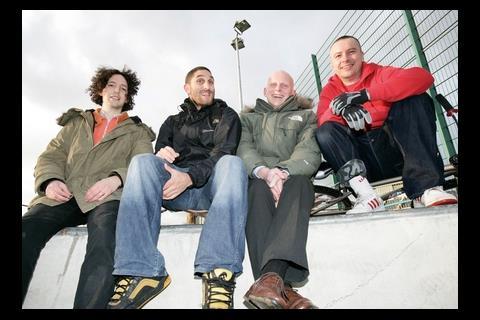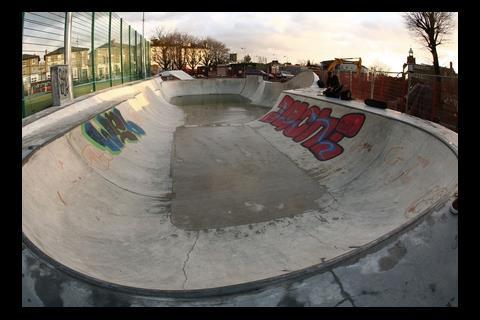Ten years in construction and 20 on a skateboard, Matt Elms is perfectly qualified to turn a patch of north London into heaven with a half-pipe.
ãLook at the finish on that!ã exclaims Matt Elms, crouching to run his finger along a paper-smooth block of solid concrete with a gleaming stainless-steel edge.
This is what skateboarders like Elms call a grindbox ã in street-skating they slide their boards along it at high speed.
Elms is giving me a tour of the new Cantelowes skatepark in north London, which heãs been project managing. Now 34, heãs been skating since he was 14. By day, Elms is a for Mace, but for the past five years, he and three skater friends have been devoting their spare time and professional skills to project managing the refurbishment of one of their old haunts.
When we catch up with him, the relaunch party is just a-week-and-a-half away, the banks and bowls where skaters will hone their tricks are in place and the hand-finishing of the concrete on the 1,000m2 site is almost complete.
ãThereãs a lot of excitement about this in the skateboarding world,ã says Elms. ãAll of us ã the skaters, the council, the contractors ã wanted to build the best skatepark in England. We volunteered because we knew we had the skills and we wanted a really good skatepark to replace the old one,ã says Elms.
ãWithin the group that skated there, there were people who had experience of design, building and engineering that we could use. We didnãt want Camden to employ someone to tell us what to do. Iãd never built or designed a skatepark before but Iãd been skating for 20 years and building for 10.ã
His opportunity came when Camden council began a ôÈ1.5m redevelopment of the shabby Cantelowes Gardens, which includes the 20-year-old skatepark. Although it had a basic design and the concrete was starting to crack, it was a favourite among skaters from across the city. Elms is from Barnet, to the north, but recalls making many trips to Camden. The council asked Elmsã friend, Perry Wilson ã a local BMXer ã if he knew anyone familiar with skatepark construction.
Elms jumped at the chance. He roped in two friends heãd met through skating ã Jeremy Donaldson, an architect at Robert Dye Associates, and Hareth Pochee, an working for Max Fordham ã and they formed the Cantelocals design team.
ãNext thing, I was in a room with four people from Camden council Iãd just met and four people from Sport England wanting to know what we wanted,ã he says.
Through Mace, the council employed Elms to project manage the submission of a bid to Sport England for ôÈ70,000. ãThat was really hard,ã he says. ãIt was the first time Iãve ever done anything like it. The application is geared towards sports centres, and not just for capital projects but also for timetabled teaching. But with skateboarding nobody really teaches you; you teach yourself. It appeals to people without the team-game spirit, who donãt like being competitive or the hassle of being at a certain place at a certain time to be taught something.ã
Nevertheless, the money came through and the Cantelocals set about developing designs with landscape architect Watkins:Daly. The team wanted the park to allow as many people as possible to skate together, to accommodate skaters of all abilities, and to offer a variety of terrain. They opted for equal amounts of banks, bowls and streetscape of varying gradient and height.
They were determined to avoid errors made in other parks. ãSo many councils build them with tarmac floors rougher than the road and then fibreglass banks that make a humming noise when youãre on them and a metal lip in between that jolts you,ã says Elms.
Today, Donaldson has taken a late lunch to help hand-finish the last bits of concrete around the edge of the bowl. The Cantelocals have not only pored over how every inch of space is used but theyãre also there most days to help with the building work.
He says that to design the park, they had to think about the different routes people would take as they skated. ãI wanted to have separate bowls, but that added about 40% to the cost and you ended up with very little useable space,ã he says.
Donaldson says the project has involved very different tolerances from most construction projects. ãIf the coping sticks out by a few millimetres, that inconsistency can limit the utility of the obstacle,ã he says. ãBut if the ramp itself is a foot longer it doesnãt make that much difference.ã
Finding someone to build the park was also a challenge. Elms says: ãThere arenãt many skatepark contractors in England and there arenãt many designers or other professional staff with experience in this kind of work.ã
The team looked at using US contractors but none could meet the local authorityãs risk requirements at the right price. In the end, they settled on Wheelscape, a Bristol-based skatepark specialist owned by Nick Fyfe.
ãWhen I met Nick, I couldnãt work him out,ã says Elms. ãHeãs passionate about skateparks but isnãt a skater. Then I found out: his passion is concrete, so skateparks are a unique challenge.ã
Elms is full of praise for the way the council has handled the project. ãTheyãve been transparent all the way through, and let us get close to the people building it,ã he says.
Having said that, he has found the pace agonisingly slow at times: ãLegal and technical barriers are most frustrating. But itãll be worth it when it opens.ã
He admits itãs been hard to maintain the support of the parkãs users during the project, but now itãs nearly finished thereãs a great sense of expectation. One of the most eagerly anticipated elements is the over-vert cradle ã a round lip on the edge of one of the bowls that allows skaters and BMXers to go upside-down ã the first of its kind in the UK.
The project has left Elms keen to work on more skateparks. ãPeople think itãs a fad but there are more and more skateparks around the country and theyãre always going to be used by BMXers or rollerbladers or whatever.
ãIãve been skateboarding for 20 years and my wife skates, and when we have a kid, he or she will do it too. Iãm never going to stop.ã


























No comments yet